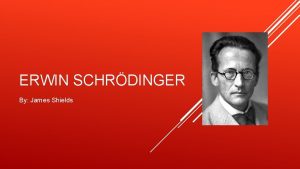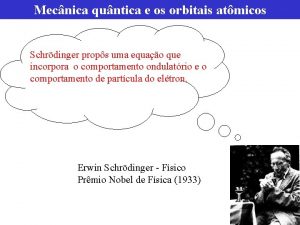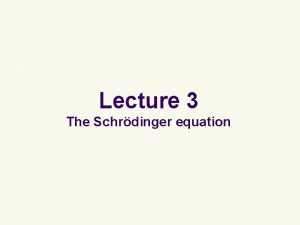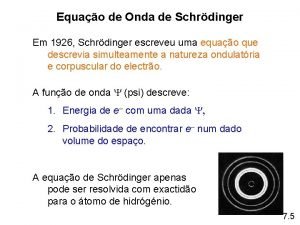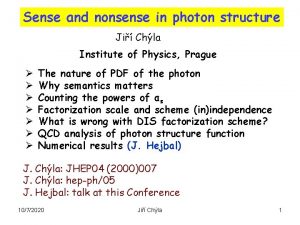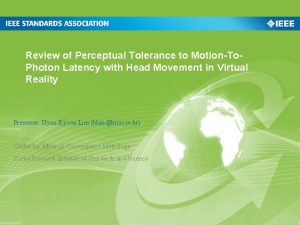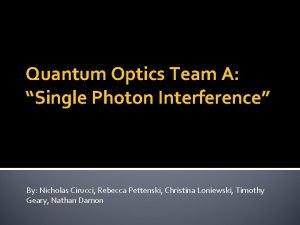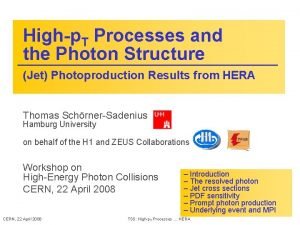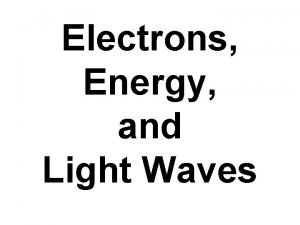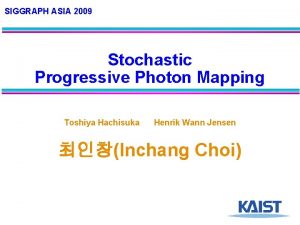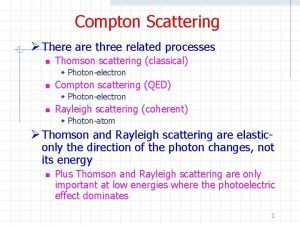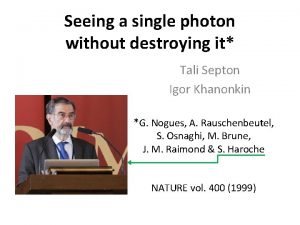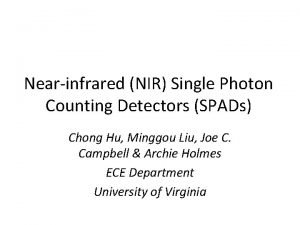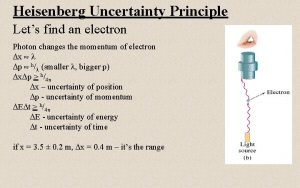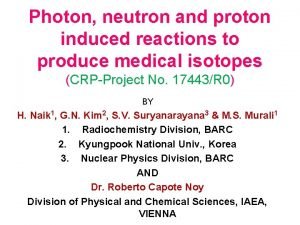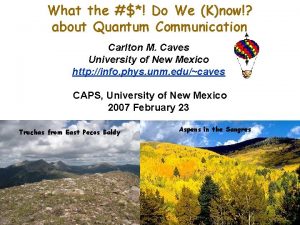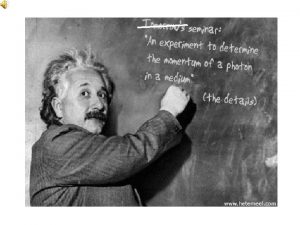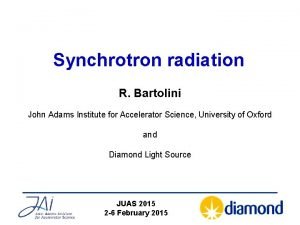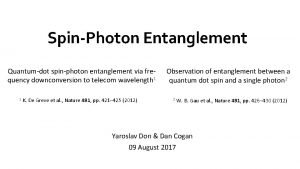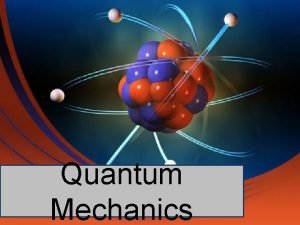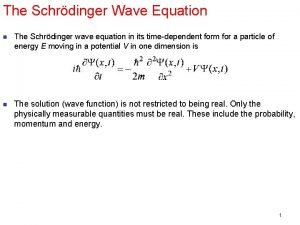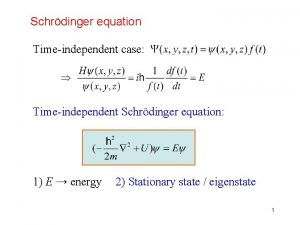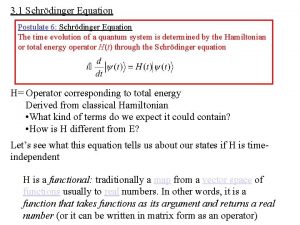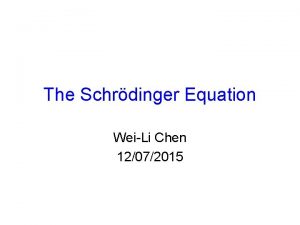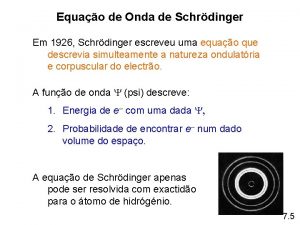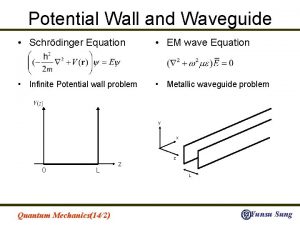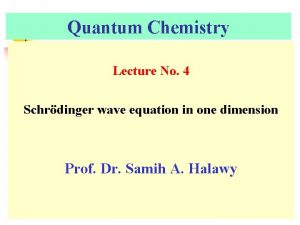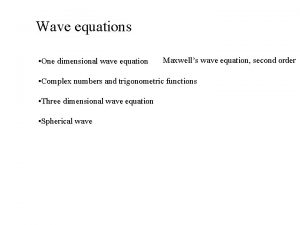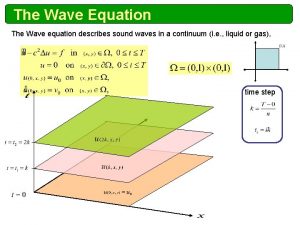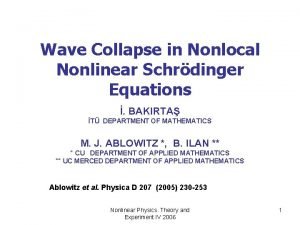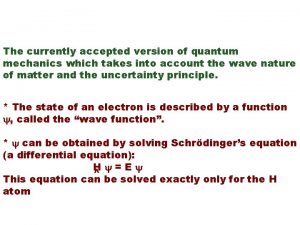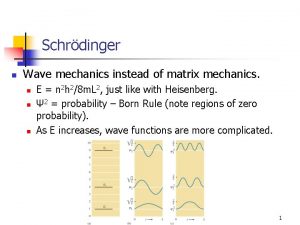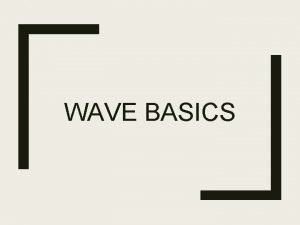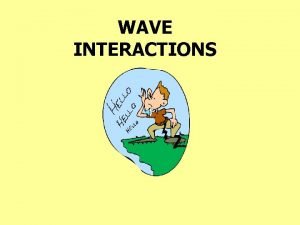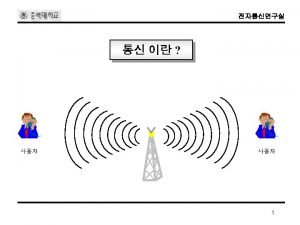Topic 5 Schrdinger Equation Wave equation for Photon































- Slides: 31

Topic 5: Schrödinger Equation • Wave equation for Photon vs. Schrödinger equation for Electron+ • Solution to Schrödinger Equation gives wave function – 2 gives probability of finding particle in a certain region • Square Well Potentials: Infinite and Finite walls – oscillates inside well and is zero or decaying outside well, E n 2 • Simple Harmonic Oscillator Potential (or parabolic) – is more complex, E n Example Infinite Well Solution Page 1

Schrödinger Equation • Step Potential of Height V 0 – is always affected by a step, even if E > V 0 – For E > V 0, oscillates with different k values outside/inside step. – For E < V 0, oscillates outside step and decays inside step. • Barrier Potential of Height V 0 – oscillates outside and decays inside barrier. • Expectation Values and Operators • Appendix: Complex Number Tutorial Page 2

Wave Equation for Photons: Electric Field E 2 nd space derivative 2 nd time derivative Propose Solution: Calculate Derivatives: After Substitution: Page 3

Schrödinger Eqn. for Electrons+: Wave Function 2 nd space derivative 1 st time derivative Propose Simple Solution for constant V: Calculate Derivatives: After Substitution: Page 4

Schrödinger Equation: Applications • Now, find the eigenfunctions and eigenvalues E of the Schrödinger Equation for a particle interacting with different potential energy shapes. (assume no time dependence) • Possible potential energies V(x) include: • Infinite and Finite square wells (bound particle). • Simple Harmonic or parabolic well (bound particle). • Step edge (free particle). • Barrier (free particle). Page 5

Schrödinger Equation: Definitions • Wave function has NO PHYSICAL MEANING! • BUT, the probability to find a particle in width dx is given by: • Normalization of – Probability to find particle in all space must equal 1. – Solve for coefficients so that normalization occurs. Page 6

Infinite Square Well Potential: Visual Solutions Wave and Probability Solutions n=3 n(x) Energy Solutions n 2(x) n=2 n=1 Page 7

Infinite Square Well: Solve general from S. Eqn. Inside Well: (V = 0) where Oscillatory Outside Well: (V = ) cannot penetrate barriers! Page 8

Infinite Square Well: Satisfy B. C. and Normalization • Satisfy boundary conditions Quantized Energy Solutions • Satisfy normalization using identity and Wave Solutions Page 9

Finite Square Well Potential: Visual Solutions Wave and Probability Solutions n=3 “leaks” n(x) outside barrier n Energy Solutions E 2(x) High energy particles “escape” Vo E 3 n=2 E 1 n=1 Energy vs. width: Energy vs. height: http: //www. kfunigraz. ac. at/imawww/vqm/pages/supplementary/107 S_07 a. html http: //www. kfunigraz. ac. at/imawww/vqm/pages/supplementary/107 S_07 b. html Page 10

Finite Square Well: Solve general from S. Eqn. Inside Well: (V = 0) where Oscillatory Outside Well: (V = Vo) Decaying where can penetrate barriers! Page 11

Finite Square Well: Example Problem (a) Sketch the wave function (x) for the n = 4 state for the finite square well potential. (b) Sketch the probability distribution 2(x). Page 12

Finite Square Well: Example Problem Sketch the wave function (x) corresponding to a particle with energy E in the potential well shown below. Explain how and why the wavelengths and amplitudes of (x) are different in regions 1 and 2. • (x) oscillates inside the potential well because E > V(x), and decays exponentially outside the well because E < V(x). • The frequency of (x) is higher in Region 1 vs. Region 2 because the kinetic energy is higher [Ek = E - V(x)]. • The amplitude of (x) is lower in Region 1 because its higher Ek gives a higher velocity, and the particle therefore spends less time in that region. Page 13

Simple Harmonic Well Potential: Visual Solutions Wave and Probability Solutions n=2 n(x) n 2(x) (different well widths) Energy Solutions n=1 n=0 Page 14

Simple Harmonic Well: Solve from S. Eqn. NEW! Inside Well: where (x) is not a simple trigonometric function. Outside Well: where (x) is not a simple decaying exponential. Page 15

Step Potential: (x) outside step Outside Step: V(x) = 0 where Y(x) is oscillatory Case 1 Case 2 Energy (x) Page 16

Step Potential: (x) inside step Inside Step: V(x) = Vo where Y(x) is oscillatory for E > Vo Y(x) is decaying for E < Vo Case 1 Case 2 Energy E > Vo E < Vo (x) Scattering at Step Up: http: //www. kfunigraz. ac. at/imawww/vqm/pages/samples/107_06 b. html Scattering at Well - wide: http: //www. kfunigraz. ac. at/imawww/vqm/pages/supplementary/107 S_05 d. html Scattering at Well - various: http: //www. kfunigraz. ac. at/imawww/vqm/pages/supplementary/107 S_05 b. html Page 17

Step Potential: Reflection and Transmission • At a step, a particle wave undergoes reflection and transmission (like electromagnetic radiation!) with probability rates R and T, respectively. R(reflection) + T(transmission) = 1 • Reflection occurs at a barrier (R 0), regardless if it is step-down or step-up. – R depends on the wave vector difference (k 1 - k 2) (or energy difference), but not on which is larger. – Classically, R = 0 for energy E larger than potential barrier (Vo). Page 18

Step Potential: Example Problem A free particle of mass m, wave number k 1 , and energy E = 2 Vo is traveling to the right. At x = 0, the potential jumps from zero to –Vo and remains at this value for positive x. Find the wavenumber k 2 in the region x > 0 in terms of k 1 and Vo. In addition, find the reflection and transmission coefficients R and T. Page 19

Barrier Potential where Outside Barrier: V(x) = 0 Y(x) is oscillatory where Inside Barrier: V(x) = Vo Y(x) is decaying Energy Transmission is Non-Zero! (x) http: //www. sgi. com/fun/java/john/wave-sim. html Single Barrier: http: //www. kfunigraz. ac. at/imawww/vqm/pages/samples/107_12 c. html Page 20

Barrier Potential: Example Problem Sketch the wave function (x) corresponding to a particle with energy E in the potential shown below. Explain how and why the wavelengths and amplitudes of (x) are different in regions 1 and 3. • (x) oscillates in regions 1 and 3 because E > V(x), and decays exponentially in region 2 because E < V(x). • Frequency of (x) is higher in Region 1 vs. 3 because kinetic energy is higher there. • Amplitude of (x) in Regions 1 and 3 depends on the initial location of the wave packet. If we assume a bound particle in Region 1, then the amplitude is higher there and decays into Region 3 (case shown above). Non-resonant Barrier: http: //www. kfunigraz. ac. at/imawww/vqm/pages/supplementary/107 S_resonance-5. html Resonant Barrier: http: //www. kfunigraz. ac. at/imawww/vqm/pages/supplementary/107 S_resonance-6. html Double Barrier + : http: //www. kfunigraz. ac. at/imawww/vqm/pages/supplementary/107 S_resonance-0. html Page 21

Scanning Tunneling Microscopy: Schematic Tip Bias voltage VDC e- Constant current contour e e Distance s Sample Tunneling current e -2 ks • STM is based upon quantum mechanical tunneling of electrons across the vacuum barrier between a conducting tip and sample. • To form image, tip is raster-scanned across surface and tunneling current is measured. Page 22

STM: Ultra-High Vacuum Instrument Coarse Motion Sample Scanner Tip • Well-ordered, clean surfaces for STM studies are prepared in UHV. • Sample is moved towards tip using coarse mechanism, and the tip is moved using a 3 -axis piezoelectric scanner. Page 23

STM: Data of Si(111)7× 7 Surface empty STM 7× 7 Unit 18 nm 7 nm = adatom • STM topograph shows rearrangement of atoms on a Si(111) surface. • Adatoms appear as bright “dots” when electrons travel from sample to tip. Page 24

Expectation Values and Operators • By definition, the “expectation value” of a function is: • “Operate” on (x) to find expectation value (or average expected value) of an “observable. ” Observable Symbol Momentum p Position x Operator x Kinetic energy K Hamiltonian H Total Energy E Page 25

Expectation Values: Example Problem • Find <p>, <p 2> for ground state 1(x) of infinite well (n = 1) L 0 <p> = -L/2 +L/2 <p> = 0 by symmetry (odd function over symmetric limits) Note: The average momentum goes to zero because the “sum” of positive and negative momentum values cancel each other out. Page 26

Expectation Values: Example Problem, cont. <p 2> = = 1 by normalization <p 2> = Page 27

Complex Number Tutorial: Definitions • Imaginary number i given by: i 2 = – 1 ( i 3 = –i, i 4 = 1, i– 1 = –i ) • Complex number z is composed of a real and imaginary parts. Cartesian Form: z = x + iy Polar Form: z = r(cosq + i sinq) where r = (x 2 + y 2)1/2 and tanq = y/x Exponential Form: z = rei q Conjugate: z* = x – iy = rcosq – i rsinq = re– i q where (z*)(z) = (x – iy)(x + iy) = x 2 + y 2 (real!) Page 28

Complex Number Tutorial: Taylor Series • Proof of equivalence for polar and exponential forms: Page 29

Schrödinger Eqn. : Derivation of Space & Time Dependence Schrödinger Equation is 2 nd Order Partial Differential Equation Assume is separable [i. e. V(x) only] Substitution of Partial derivatives are now ordinary derivatives Divide by (x)0(t) Space dependence ONLY Time dependence ONLY Page 30

Schrödinger Eqn. : Derivation of Space & Time Dependence Left and right sides have only space (x) and time (t) dependence now Space: Set each side of equation equal to a constant C Time: Space Equation need V(x) to solve! Time Solution: Check by substitution! Page 31
 Hψ=eψ
Hψ=eψ Erwin schrdinger
Erwin schrdinger Schrdinger
Schrdinger Schrodinger time dependent equation
Schrodinger time dependent equation Equação de onda de schrodinger
Equação de onda de schrodinger Paragraph writing strategy
Paragraph writing strategy Broad and specific topic examples
Broad and specific topic examples Photon structure
Photon structure Motion-to-photon latency
Motion-to-photon latency Wavelength units
Wavelength units Jim al khalili
Jim al khalili Photon is our business
Photon is our business Photon structure
Photon structure What are photons made of
What are photons made of Electron vs photon
Electron vs photon Photon assay
Photon assay Desy photon science
Desy photon science Stochastic progressive photon mapping
Stochastic progressive photon mapping Lepton-photon
Lepton-photon Photon cross section
Photon cross section Single photon
Single photon Single photon
Single photon Photon uncertainty principle
Photon uncertainty principle Photon neutron
Photon neutron Photon neutron
Photon neutron Ortec 257p
Ortec 257p Photon neutron
Photon neutron Photon polarization
Photon polarization Momentum of photon is
Momentum of photon is Synchrotron radiation
Synchrotron radiation Photon polarization
Photon polarization A photon checks into a hotel
A photon checks into a hotel

